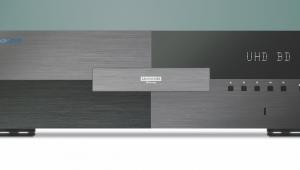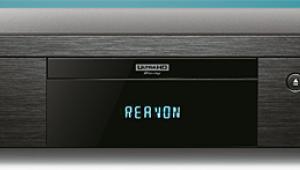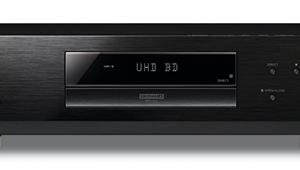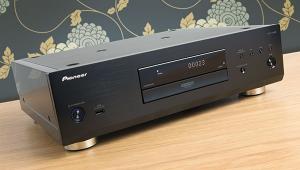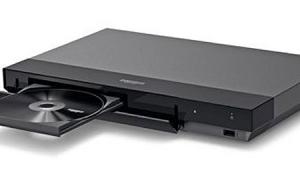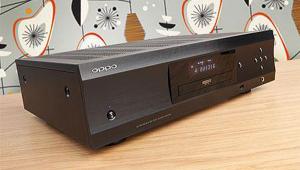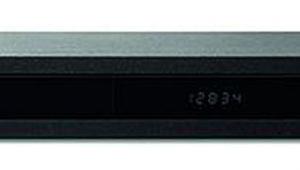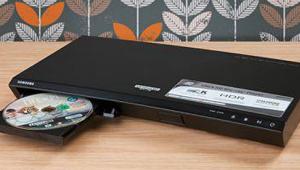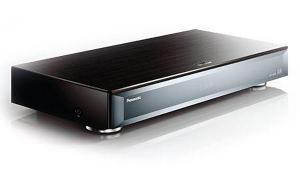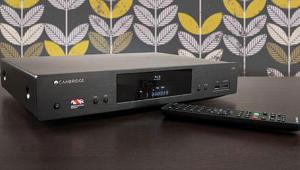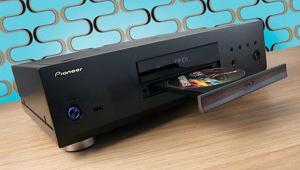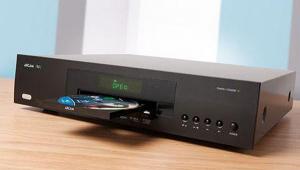Panasonic DP-UB9000 Ultra HD Blu-ray player review
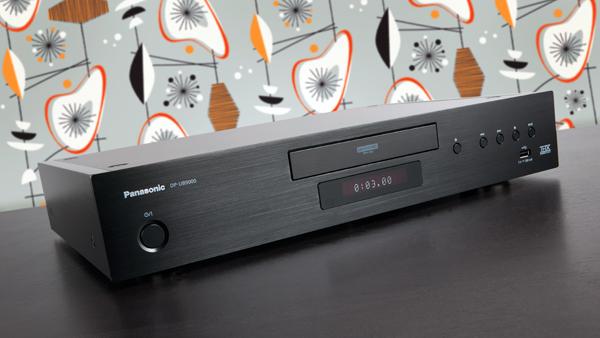
 The DP-UB9000 is an Ultra HD Blu-ray player of few compromises and many pleasures. The most ambitious disc spinner so far to emerge from Panasonic, this high-end deck is unique in offering both Dolby Vision and HDR10+ dynamic metadata support, alongside HDR10 and HLG. And that's just the tip of an iceberg of functionality.
The DP-UB9000 is an Ultra HD Blu-ray player of few compromises and many pleasures. The most ambitious disc spinner so far to emerge from Panasonic, this high-end deck is unique in offering both Dolby Vision and HDR10+ dynamic metadata support, alongside HDR10 and HLG. And that's just the tip of an iceberg of functionality.
My first thought when unboxing was that someone had bungled the retail price. The UB9000 looks considerably posher than you might expect for the sub-£1K tag. Attention to detail is awe-inspiring.
A two-layer steel construction means the deck is reassuringly weighty. There's no simple chassis sleeve here. The double-layer top plate and aluminium side plate are separately bolted, and the base of the chassis, also dual-layer, consists of 1.2mm and 1.6mm sheets. If there's anything inside, it's not getting out.
Corners are rolled and smooth. A hairline finish on the front panel lends the player a minimalistic, upmarket demeanour. Four substantial isolating feet have anti-slip pads. Once down, it stays planted.
Connections are generous, too. In addition to two HDMI outputs (one for audio only), there are two USB ports (one a fast v3.0), optical and coaxial digital audio outputs, stereo analogue phonos and a full 7.1-channel output, plus balanced XLR stereo connectors. Ethernet is provided to support internal Wi-Fi.
Powered up, it's clear there's been a minor cosmetic upgrade to the user interface (it's a little cleaner), but the navigation is unchanged from the rest of the Panasonic BD fleet. There are buttons for Videos, Music, Photos, Home Network, Network Service and Setup.
Unlike the now departed Oppo UDP-205 and Oppo UDP-203 players, and the incoming Pioneer UDP-LX500 and UDP-LX800 UHD machines, Panasonic hasn't shortchanged users on streaming apps. The familiar-looking service portal supplies Netflix, Amazon Prime Video, YouTube, BBC News/Sport, plus the Berlin Philharmoniker channel. I would have liked to have seen a greater focus on streaming audio services, but I suppose you can't have everything.
Check out my data talents!
Once spinning a disc, it doesn't take long to discover the in-depth Playback Info screen – given that you can access it directly from the IR remote control. Amid a bunch of useful disc information, it rather helpfully reads HDR10 metadata, revealing Maximum Frame-Average Light Level (MaxFALL) and Maximum Content Light Level (MaxCLL) figures from playing platters. For example, I'm told that Pacific Rim: Uprising (one of the UHD titles used to assess image quality) was mastered for 1,000 nits and has an MaxFALL of 863 nits. This kind of minutia is endless fascinating in a geeky sort of way. While not every disc proffers MaxFALL and MaxCLL info (Star Wars: The Last Jedi is blank on the subject, presumably because such levels weren't set in the metadata), knowing that Despicable Me 2 boasts a max average HDR brightness of 553 nits is certain to make me a big hit at parties.
Ultimately, the raison d'être of the DP-UB9000 is image quality. The visuals from this deck, which has THX 4K HDR Source certification, are positively jaw-dropping. Intensely detailed, with wide smooth colour, it presents peerless pictures.
Some of this prowess can be attributed to Panasonic's second-generation HCX video processor. An evolution of what we saw in the earlier well-specified DMP-UB900 (launched in 2016), it includes a number of HDR refinements, including an HDR Optimizer to partner the player with a display.
This latter adjustment is powerful but intuitive to use. You can select OLED, High Luminance Projector, Basic Luminance Projector, Super High Luminance LCD, Middle or High Luminance LCD and Basic Luminance LCD – choose which best describes your display.
The Optimizer aims to prevent clipping on lower-brightness TVs/projectors by setting a tone map target and carrying out metadata conversion in the player. Panasonic's reasoning is that not all TVs will accurately tone map (that's to say, compensate for any shortfalls in luminance), particularly when content has been mastered above 1,000 nits, leading to (for example) bleached-out white cloudy skies, lacking in no apparent detail. The Optimizer was tried with a Sony LED LCD TV of only middling HDR brightness, and worked well. Compensation is scalable, too – the HDR Optimizer can set a specific tone map luminance. This is a powerful tuning tool.

High-precision hues
Beyond this, there's not a great deal required during setup. The DP-UB9000 will cope with most situations in Auto mode.
A 4K High Precision chroma processor and Multi-Tap filter are employed to interpolate a 4K 4:4:4 video output from 4K 4:2:0 content. This isn't new; Panasonic has had the technology for some years. It's designed to produce a more saturated, yet smooth, response than conventional processing, and works with both UHD discs and network streaming services.
A magnified snapshot of a 4K zone plate chroma frequency response test confirms perfectly delineated micro curves, with no coarse stepping. Smooth colour detail, authentic to the source, makes its imagery suitably cinematic.
Vibrancy and HDR pizzazz are class-leading. Pacific Rim: Uprising is a gorgeously clean and dynamic UHD disc, with oodles of fine detail and crisp, grain-free visual effects. Played on the DP-UB9000, the action becomes almost mesmeric. When the rogue Jaeger, Obsidian Fury, first attacks, the deck renders every aspect of the fast-moving fight with three-dimensional precision. I wasn't looking at the picture, I was looking into it.
Colour saturation and gradations appear flawless. The animation in Despicable Me 2, another Dolby Vision HDR release, glows with gloriously rendered primaries and tight, bright highlights.
Rattle and hum? Nope
In use, the DP-UB9000 is agile and stable. The chassis features a newly developed drive base and centre mechanism, and the drive sits within a vibration-reducing cradle. There's no rattle when loading discs, with the mechanism proving smooth and rigid, and disc loading is fast, taking a Java-heavy movie Blu-ray from tray to main menu in 40 seconds.
If the DP-UB9000 does have an Achilles' heel, it's sonic. Despite its premium positioning, this isn't a universal disc player, and won't spin Super Audio CD or DVD-Audio – it's CD only. Those with treasured collections of formative high-res formats may find this omission a bitter pill.
That said, Panasonic hasn't skimped on the audio specification. The deck employs a 768kHz/32-bit AK4493 DAC for its two-channel output, and to further help preserve audio integrity there's a dedicated power supply plus a special circuit board for the analogue audio output that routes left and right channels through a low-noise op-amp to those balanced XLR outputs. There's also an HDMI low-jitter clock process, if that's your preferred interconnect option.
Don't get me wrong. CD playback is unquestionably good, even occasionally excellent when fed premium CDs that have been mastered with care. However its character is somewhat acerbic. The more I listened to the deck, the more I found its CD playback a tad fatiguing. I began to notice a slight sense of distortion, or buzz, on some harmonics. I'm being pedantic, but only because this calibre of kit deserves it.
The deck is hi-res audio compliant, though, and will handle DSD and 24-bit FLAC files (amongst others). These sound far more fabulous. If your high-res interests lie with files, streaming and Blu-ray Audio discs, the DP-UB9000 doesn't disappoint.

The top of the tree
With its beautiful battleship build and class-leading video quality, the DP-UB9000 can be considered a steal for the asking price. Panasonic has nailed the high-end aesthetic too. Yes, it borrows a bit from the Oppo playbook, but seemingly no expense has been spared in its construction. It's a gorgeous thing.
Usability is also excellent. That Playback Info screen has huge nerd appeal, and the provision of both Dolby Vision and HDR10+ support makes it a unique HDR proposition. Your chosen TV will most likely only support one of these dynamic HDR standards, but at least the deck has pan-HDR user appeal. Panasonic would no doubt have liked some HDR10+ discs to have arrived by now, but can't be blamed for the delay.
Audio performance is very good, although I'd venture to say it's not audiophile-grade, at least when it comes to CD playback. There's an indefinable grittiness that gives it a sharp edge. Stick with hi-res files and your ears will have few complaints.
And image quality? The provision of extensive video adjustment, with HDR optimisation that offers a real-world benefit and a 4K Chroma processor that paints with supreme artistry, put this deck at the top of tree.
 |
Home Cinema Choice #351 is on sale now, featuring: Samsung S95D flagship OLED TV; Ascendo loudspeakers; Pioneer VSA-LX805 AV receiver; UST projector roundup; 2024’s summer movies; Conan 4K; and more
|

